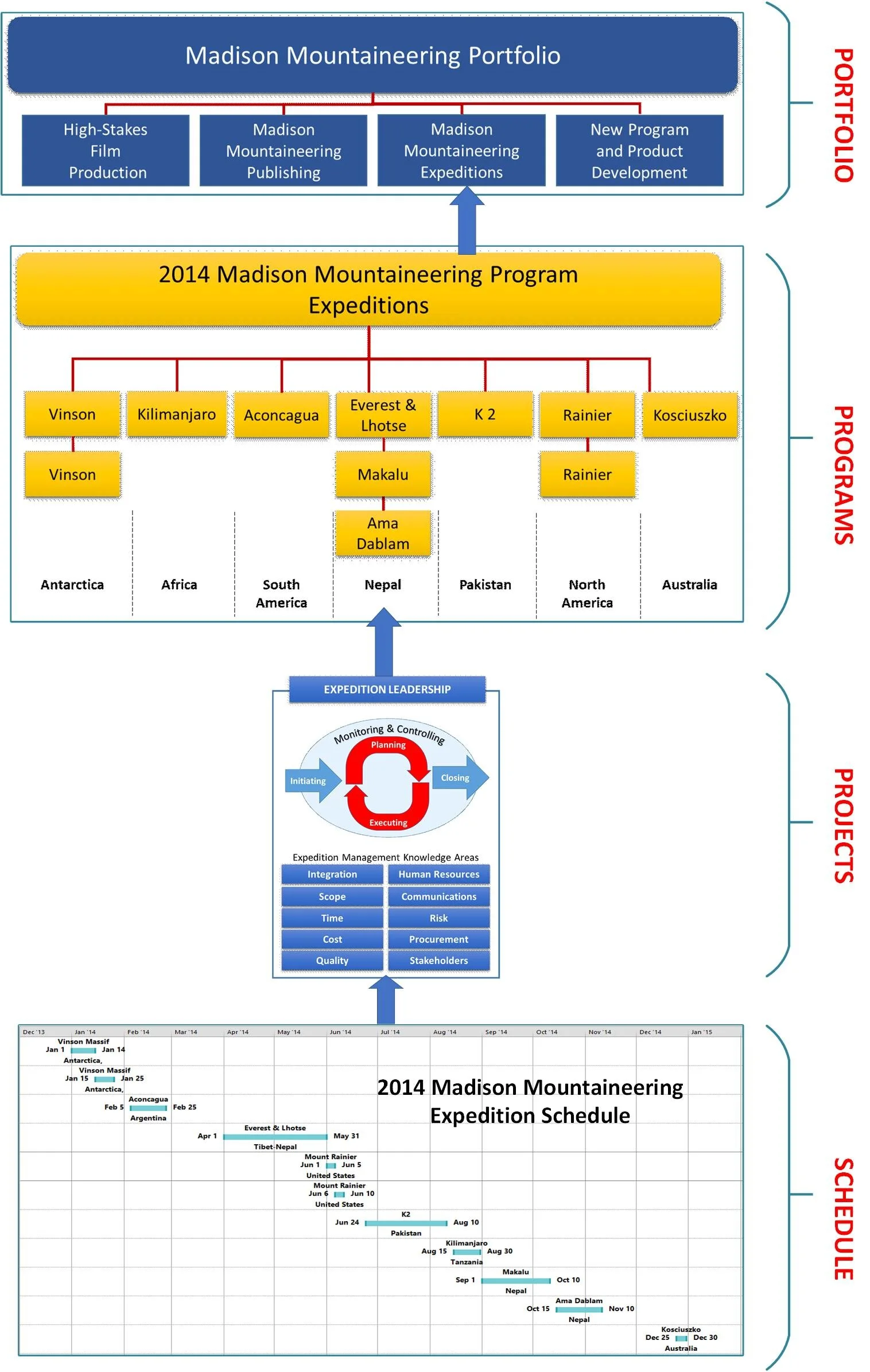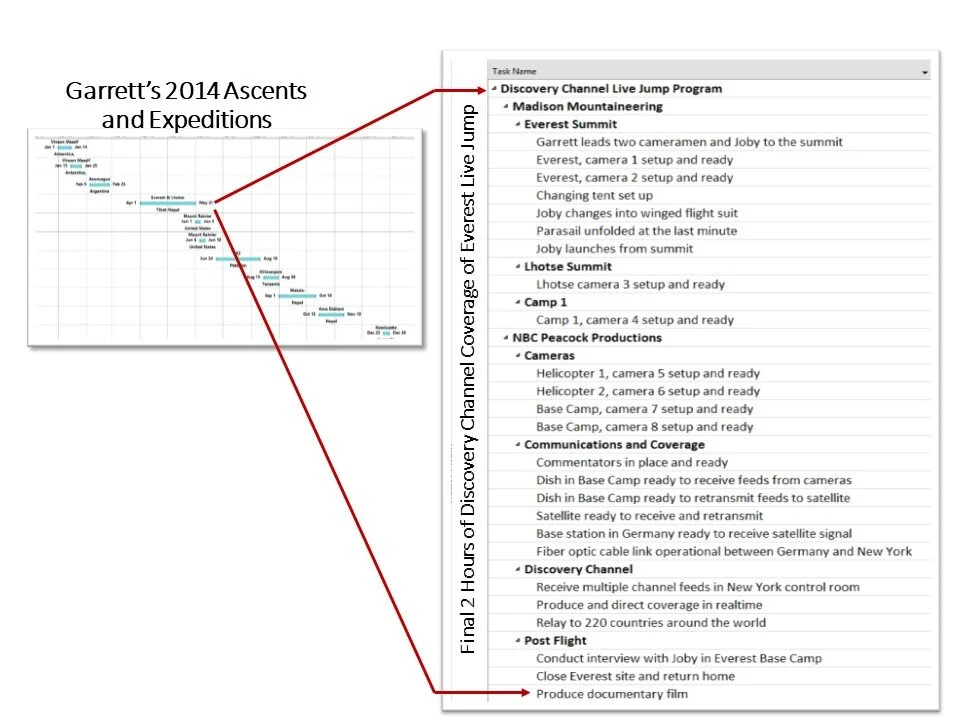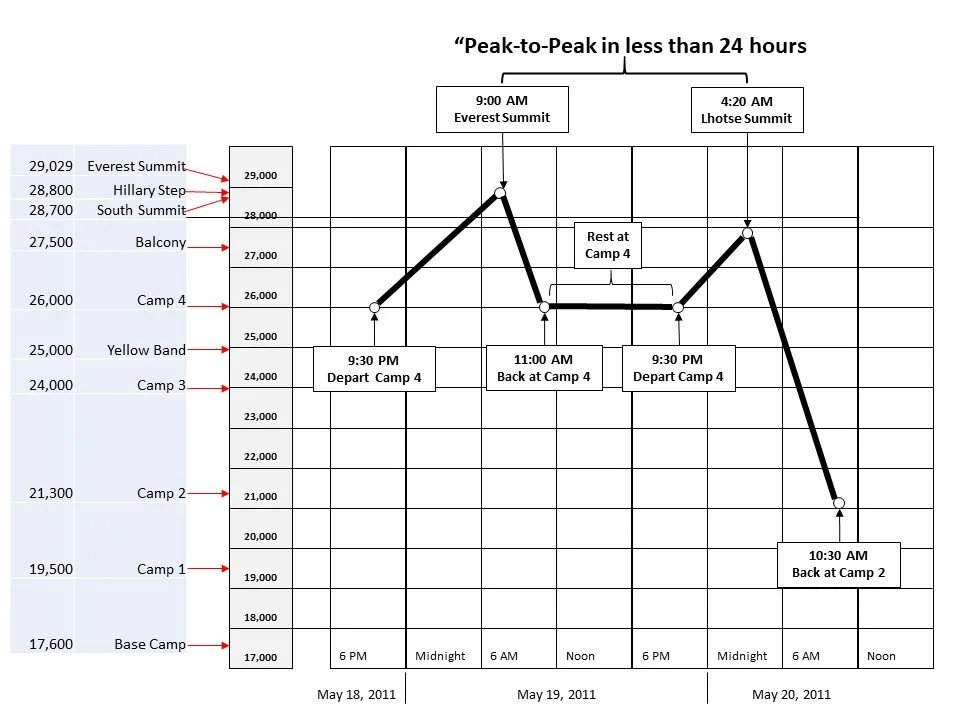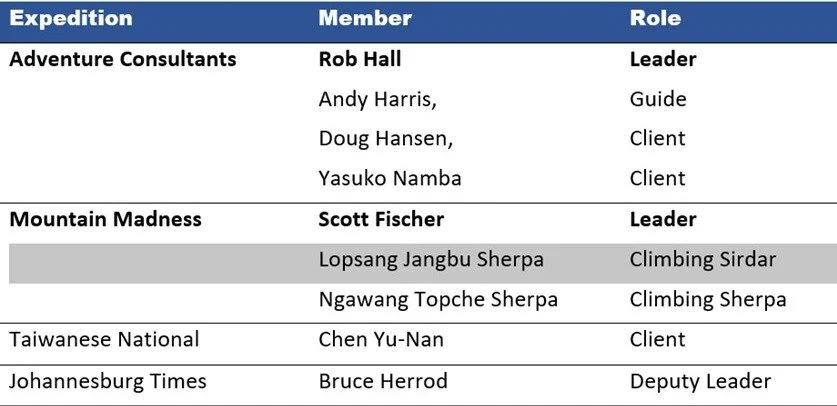The High-Stakes Leadership (HSL) model used in this book is based three factors:
1) What is the depth and breadth of your relevant experience?
2) What is the state of your physical and mental health?
3) Do you have sufficient free attention and bandwidth to be effective in high-stakes environments?
High-Stakes Leadership (HSL) is a function of the
strength of the 3 factors and the degree that they overlap
Expedition Stakeholders
The expedition leader has obligations
to numerous stakeholders.
Expedition Leader Functions
In many ways these functions are similar to those an army infantry company commander.
2014 Madison Mountaineering Portfolio
High-Stakes Film Production
Madison Mountaineering Publishing
Madison Mountaineering Expediton
New Program and Product Development
Program of 2014 Expeditions
Expedition Project Management
2014 Expedition Schedule
Physical and Mental Health Indicators
Basic Situational Awareness
Assess
Decide
Act
Adjust
Perception, Comprehension, and Projection in Situational Awareness
External Factors Driving Situational Awareness
High-Stakes Leadership
Impacting
Situational Awareness
Case Study
High-Stakes Leadership and Situational Awareness
Into Thin Air, by Jon Krakauer, has sold 800,00 hardcover copies plus 1,760,000copies in paperback. It has been translated into 19 languages.
Jon Krakauer was commissioned by Outside magazine to chronicle a guided ascent of Mount Everest. The expedition leader was Rob Hall. That year nine climbers lost their lives, including two expedition leaders, Rob Hall and Scott Fisher. The tragedy occurred over several days beginning on May 10, 1996. Krakauer’s article was published in Outside that September, and his book, Into Thin Air, the following year.
Scott Fischer, Expedition Leader, Mountain Madness
As reported by Jon Krakauer in Into Thin Air
Depth and Breadth of Experience (DBE).
Had climbed Everest in 1994 without bottled oxygen. (Page 7)
Fischer had attempted Everest four times. His summit in 1994 was not as a guide. (Page 75)
Fischer had only guided one expedition on an 8000 m mountain, Broad Peak at 26,400 feet. (Page 74)
Physical and Mental Health (PMH).
When Fischer reached it Hillary Step, Krakauer was surprised at how slowly Fischer was moving and hammered he looked. (Page 9)
Fischer’s wife lost her well-paying job that had enabled him to climb full-time and launch his company, Mountain Madness. (Page 77)
Revenues from Fischer’s guiding business weren’t nearly enough to make up for the loss of his wife’s income. (Page 81)
Scott Fischer and Rob Hall were business rivals. (Page 75)
Fischer was aware of Rob Hall success in guiding expeditions on Everest and the large fees he was earning. Fischer decided he was ready to enter the Everest market which had the potential of quickly moving his company, Mountain Madness, to profitability. (Page 82)
Fischer had lobbied Brad Wetzler, an editor at Outside [magazine] to have Krakauer join him on an Everest expedition. About a month before departure, Rob Hall offered Wetzler a significantly lower price to include Krakauer as a member of Hall’s expedition. (Page 84)
Hall charged Outside only $10,000 to include Krakauer in the expedition, with the remainder to be bartered for ad space in the magazine. Fischer did not offer to match Hall’s price, and he was extremely upset at losing Krakauer and the potential publicity, (Page 84)
Krakauer states, “in January, when Fischer found out that Hall had won me away from his team, he was apoplectic.” (Page 85)
Late in the afternoon on May 6, in Camp 2 at 21,000 feet, still 8000 feet below the Everest summit, Fischer “… looked anxious and extremely tired,” according to Krakauer. (Page 187)
Fischer had made a number of unplanned trips back to base camp to escort down from the higher camps climbers who were having difficulties at the higher altitudes. (Page 187)
Fischer had a difficult, strained relationship with Anatoli Boukreev on a number of occasions as reported throughout Krakauer’s book. Fischer had paid $25,000 to be his chief guide, when, according to Krakauer, most of the guides were paid approximately half that amount. (Page 188)
As quoted in Into Thin Air, one of Fischer’s clients, Dale Kruse, reported, “Scott laid into Toli pretty good. He [Fischer] wanted to know why he was so far behind it – why he wasn’t climbing with the team.”
Krakauer writes, “…Boukreev’s performance hadn’t been meeting his [Fischer’s] expectations.” Kruse observed, “Toli was very strong and a very good technical climber, but he had poor social skills. He didn’t watch out for people. He just wasn’t a team player. Kruse had told Fischer earlier, … I didn’t want to have to climb with Toli high on the mountain, because I doubted that I be able to count on him what it really mattered” (page 190)
Free Attention and Bandwidth (FAB)
Based on Jon Krakauer’s observations, listed above, as Scott Fischer climbed from Base Camp to the Summit of Everest, both his physical and mental health, and his free attention and bandwidth diminished significantly.
High-Stakes Leadership (HSL)
With his physical and mental health (PMH), and free attention and bandwidth (FAB) significantly diminished, Scott Fischer’s capacity for decision-making and high-stakes leadership were at a minimum by the time he reached the Summit. In the hypothetical scenario shown below, upon leaving Base Camp, his High-Stakes Leadership Index (HSL Index) was already down to 61%. By the time he reached the Summit, his HSL Index was only 2%, or virtually nonexistent. While the values assigned to DBE, PMH, and FAB in the graphic shown below are the authors’, readers are encouraged to assign their own values to the HSL Index by clicking on the button below to download an Excel file to calculate an HSL Index.


















